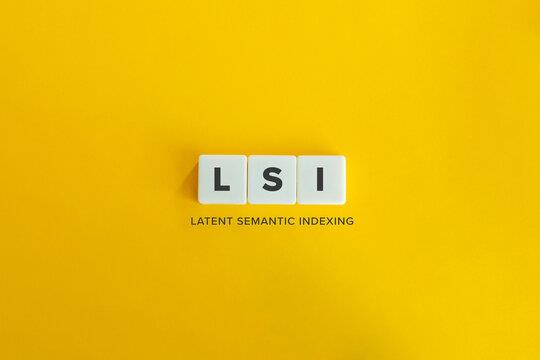Search here

01-Nov-2022
What is latent semantic indexing
In SEO, LSI is an important element to consider when optimizing your website and blog content. But what exactly is LSI, and how can it benefit your SEO efforts? In this blog post, we will explore the concept of Latent Semantic Indexing and how it can be used to improve your SEO. We will also discuss some of the best practices for using LSI in your content marketing strategy.
What is LSI
- Latent semantic indexing (LSI) is a statistical technique for analyzing relationships between a set of documents and the terms they contain. LSI is based on the principle that words that are used together in a document tend to be related to one another.
- LSI can be used to improve the accuracy of information retrieval systems, such as search engines. When a user enters a query into a search engine, the engine uses LSI to identify documents that are relevant to the query.
- LSI can also be used to cluster documents together based on their content. Clustering is a way of grouping documents together that are similar to each other.
- There are many different applications for LSI, including text classification, recommender systems, and Plagiarism detection.
How does LSI Work
- Latent Semantic Indexing is a technique used by search engines to better understand the relationships between words in a piece of text. By understanding these relationships, search engines can more accurately match a user's query with relevant documents.
- LSI relies on a mathematical concept called singular value decomposition (SVD) to reduce the dimensionality of a large matrix of word co-occurrence data. This reduction in dimensionality allows LSI to more easily identify the underlying relationships between words.
- Once the relationship between words has been identified, LSI can then be used to expand a user's query. For example, if a user searches for 'cat,' LSI might return results that include 'kitten,' 'feline,' and 'animal.' This expansion of the query helps the search engine find documents that are more relevant to the user's needs.
Benefits of LSI
- Latent Semantic Indexing is a technique used by search engines to improve the relevancy of their results.
- LSI works by using a mathematical process to analyze a body of text and identify relationships between the terms therein. This process is known as 'singular value decomposition' (SVD).
- The result of this analysis is a list of relationships between terms, which can be used to improve the relevancy of search results.
There are several benefits of using LSI:
1. It can improve the relevancy of search results.
2. It can help to identify synonyms for important keywords.
3. It can help to disambiguate terms with multiple meanings.
4. It can reduce the number of irrelevant results returned for a given query.
Different Types of LSI
Latent Semantic Indexing (LSI) is a technique used to analyze relationships between concepts in a body of text. LSI looks at the context of words and phrases to determine their meaning. This allows it to identify synonyms and related terms that may be used to describe the same concept.
There are three different types of LSI:
1. Keyword-based LSI: This approach uses a keyword list to identify related terms and concepts. It looks for words that co-occur with the keywords and assigns them a score based on how often they appear together.
2. Corpus-based LSI: This approach analyzes a body of text as a whole, looking for relationships between concepts. It doesn't rely on any preconceived notions about what the text contains.
3. Hybrid LSI: This approach combines aspects of both keyword-based and corpus-based LSI. It starts with a list of keywords but also looks at the overall context of the text to identify related concepts.
How to Use LSI
- Latent Semantic Indexing is a way of looking at words in a text to determine their meaning. It looks at the context of the words to work out their relationships.
- This can be used to improve search results by matching queries with documents that contain the same meaning, even if the words are different.
- It can also be used to identify synonyms and related terms automatically. This can be useful for things like content generation and improving search results.
- To use LSI, you need a text corpus that you want to analyze. This can be a collection of documents, or just a single document. You also need a list of keywords that you want to analyze.
- Once you have these, you can run latent semantic analysis on the text corpus using the keywords. This will produce a set of results that show the relationships between the keywords and the meanings of the text.
Conclusion
Latent Semantic Indexing (LSI) is a method of improving the accuracy of information retrieval by using the context of documents to better understand the meaning of search terms. LSI looks at both the individual words in a document and how those words are related to each other, making it more effective than traditional keyword-based search methods. As our world becomes increasingly digital, LSI is becoming an increasingly important tool for businesses and individuals alike who need to make sure they're getting accurate and relevant results from their searches.

SEO and Content Writer
I am Drishan vig. I used to write blogs, articles, and stories in a way that entices the audience. I assure you that consistency, style, and tone must be met while writing the content. Working with the clients like bfc, varthana, ITC hotels, indusind, mumpa, mollydolly etc. has made me realized that writing content is not enough but doing seo is the first thing for it.
Join Our Newsletter
Subscribe to our newsletter to receive emails about new views posts, releases and updates.
Copyright 2010 - 2025 MindStick Software Pvt. Ltd. All Rights Reserved Privacy Policy | Terms & Conditions | Cookie Policy